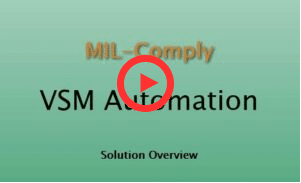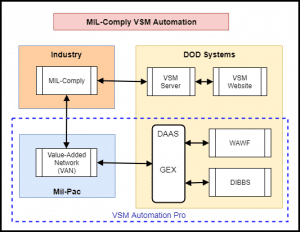DLA’s Vendor Shipment Module (VSM) is of great value to the DLA in managing logistics for defense contractors while reducing transportation costs to the Government. Mil-Pac has made using it easier and faster by integrating VSM transactions into the MIL-Comply labeling process, allowing users to bypass the VSM website altogether. Take a look at our VSM Automation video to see how this works.

The information returned by VSM is pulled into MIL-Comply shipments to complete the Military Shipment Label (MSL). This data also flows into a Receiving Report (DD250) and invoice for the shipment that can be transmitted to Wide Area Workflow (WAWF), allowing you to avoid that web site as well.
How It Works
Preparing your container labels collects most of the data that is required by VSM. Simply add in the requisition number (if applicable) and the weights and dimensions of the containers. At this point the container labels may be printed, or you can defer that until VSM sends you shipping instructions, allowing you to create the Military Shipment Label (MSL). In either case, it just takes a single button click for MIL-Comply to communicate with VSM to request the TCN and the Ship-To and Mark-For addresses. This data flows onto the MSL and DD250 automatically, ready for WAWF submission (explained below). All of this without ever logging into the VSM website.
For small parcel shipments, the results are immediate. Besides the MSL data, VSM will send the small parcel (UPS/FedEx) shipping labels, along with their DD1387 and packing list, should you want to use those.
Loads requiring transportation by common carriers (TL/LTL), you will still have to wait for DLA to send you an email notification that the transportation documents (GBL, etc.) have been prepared. Then simply pop back into MIL-Comply to print those documents along with the MSL label(s).
The VSM Automation feature integrates with Comply/Labeling to seamlessly perform the tasks that you would otherwise have to log into the DLA website to do. It also includes a more streamlined way of printing Mil-Std-129R labels (unit, intermediate, exterior and pallet formats). The Automation feature can be added to any Comply/Labeling license. It can also be run directly from Comply/Shipper dashboard, allowing you to use Shipper to organize your shipments.
VSM Automation uses the same thermal-transfer printers that are used for Mil-Std-129 labels, as well as for UPS labels, producing high quality Military Shipment Labels and carrier transportation labels. Of course, it works with standard Windows laser and inkjet printers as well.
VSM Automation with DIBBS and WAWF
The VSM Automation Pro bundle goes a couple of steps further to expedite the shipping process. First, by exploiting MIL-Comply’s ability to automatically create shipments by importing DIBBS electronic (EDI-850) purchase orders from DLA. This eliminates practically all data-entry, except for weights, dimensions, and date of packaging. Next, it allows you to electronically submit shipments to Wide Area Workflow (via EDI), eliminating the need to use the WAWF website to create a Receiving Report (DD250) and invoice.
Creating Shipments for VSM Automation
Higher shipment volumes place a greater importance on efficiency. And on accuracy. MIL-Comply offers several methods of importing data to reduce or eliminating unnecessary data-entry. These methods range in scope to discrete data items to complete shipments, depending on the source of shipment data and/or how it is maintained in your business systems.
Here are a few ways to import shipment data into MIL-Comply:
- EDI (X12-850) Purchase Orders from DIBBS – provide 95% of data required for Mil-Std-129 labeling and WAWF transactions.
- Full or partial shipment import from ERP (or other business system) – provides as much data you can support. Two formats available:
- CSVmp – a multi-dimensional CSV file for WAWF shipment & invoice creation
- M12 – a simple paired-data plain-text format
- Shipment Templates – maintained in Shipper and Labeling for reoccurring shipments.
- Contract data maintained by Comply/Contracts.
- Reusable shipment data components (stored in databases)
- Addresses, stored by DODAAC or CAGE.
- Parts Catalog, stored by NSN or Part Number
- UIDs and/or serial numbers provided via
- Clipboard, from any number of sources
- CSV file
If you have any of this kind of data available, MIL-Comply can probably use it to expedite shipment processing.
More about the Vendor Shipment Module (VSM)
The Vendor Shipment Module has been of great value to the DLA in managing transportation for defense contractors, while reducing the costs to do so. Most vendors use VSM primarily to get the Ship-To address and a Transportation Control Number (TCN) for their shipment, along with small parcel shipment labels.
Use of the VSM has allowed DLA to reduce small parcel shipment costs by using its considerable size to negotiate the best rates possible. This makes life a little easier for contractors who now longer have to worry about arranging shipments and accurately rebilling shipping costs. And it simplifies the bidding process by taking transportation costs out of the equation.
For larger shipments (TL/LTL), DLA makes arrangements with transportation carriers and provides the necessary paperwork, which it has been doing for quite some time. The Vendor Shipment Module has streamlined the process by which contractors make these requests and by which DLA delivers the required paperwork to them.
Integrating with the Vendor Shipment Module (VSM) Website
The MIL-Comply VSM integration does not replace the DLA website, but rather bypasses it, communicating directly with the DLA servers that underlie the website. Response time is immediate because the integration uses web services rather than the much slower Electronic Data Interchange (EDI) technology relied on by Wide Area Workflow. Typically, the only delays that occur are when DLA personnel need to make freight arrangements for TL/LTL shipments. Small parcel shipping labels are returned immediately, allowing for rapid completion of UPS and FedEx shipments.
The web services transactions give MIL-Comply ready access to the shipment addresses and TCN that flow onto the Military Shipment Label and WAWF Fast Pay DD250 and Invoice, eliminating the need to transcribe that data from the VSM web site.
Learn more about the Defense Logistics Agency and the Vendor Shipment Module.



